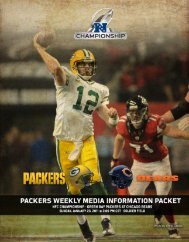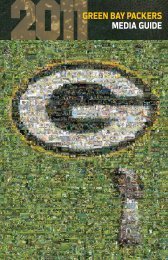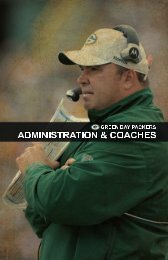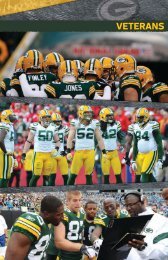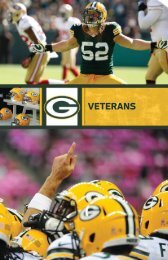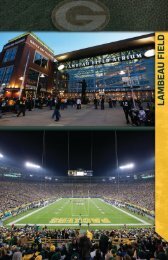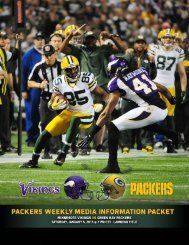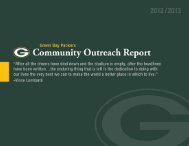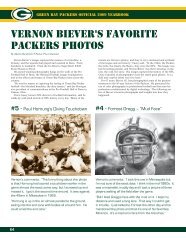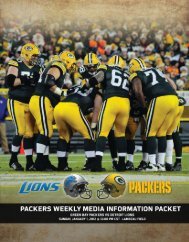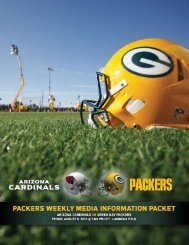THE PACKERS STORYCOMMUNITYADMIN. &COACHESVETERANSDRAFT &FREE AGENTS2012 REVIEWPACKERSSTORYLAMBEAUFIELDMISC.THE FIRST GAMEThe Packers played independently from 1919-20. Afterjoining the American Professional Football Association(renamed <strong>NFL</strong> in 1922), they played their first official leaguegame Oct. 23, 1921, a 7-6 win over the Minneapolis Marinesat Green Bay’s Hagemeister Park.With about six minutes left in the fourth quarter, theMarines muffed Cub Buck’s punt, and Dave Hayes recoveredat the Minneapolis 35. Three plays later, with the crowdchanting “Throw a forward,” Curly Lambeau hit Buff Wagnerfor 18 yards. The franchise’s first <strong>com</strong>pletion, the play set upArt Schmael’s 4-yard touchdown run. Lambeau’s extra point,with Buck holding, gave the Packers their first win.Minneapolis . . . . . . . .6 0 0 0 — 6Green Bay . . . . . . . . . .0 0 0 7 — 7Starting Lineup—LE Bill DuMoe, LT Cub Buck, LG JamesCook, C Fee Klaus, RG Sammy Powers, RT Jab Murray, REDave Hayes, QB Adolph Kliebhan, LHB Grover Malone,RHB Buff Wagner, FB Art Schmaehl.Others who played—G Joe Carey, B Lynn Howard, B CurlyLambeau, E Lyle Wheeler, G Milt Wilson.PACKERS FIRSTSGame, Win—Sunday, Oct. 23, 1921, 7-6 victory overMinneapolis Marines, Hagemeister Park, Green Bay.Loss—Oct. 30, 1921, 13-3 decision to Rock IslandIndependents, Hagemeister Park.Forward Pass—Curly Lambeau, in<strong>com</strong>plete, intended forLyle “Cowboy” Wheeler, vs. Minneapolis, Oct. 23, 1921.Reception—Buff Wagner, from Curly Lambeau, 18 yards, vs.Minneapolis, Oct. 23, 1921.Touchdown—Fullback Art Schmaehl, 4-yard run, vs.Minneapolis, Oct. 23, 1921.Touchdown Pass/Reception—Curly Lambeau to BillDuMoe, 35 yards (fake kick) vs. Hammond Pros, Nov. 13,1921, Hagemeister Park.Field-Goal Attempt—Curly Lambeau, good fromapproximately 25 yards (drop kick), vs. Rock IslandIndependents, Oct. 30, 1921, Hagemeister Park.Point After Touchdown—Curly Lambeau with Cub Buckholding, vs. Minneapolis, Oct. 23, 1921, Hagemeister Park.After Hutson’s retirement, Packer fortunes again declined. Thedisastrous pro football war, between the <strong>NFL</strong> and the new All-AmericaFootball Conference, brought on another financial crisis after the 1949season. From 1946-48, the financially strapped Packers lost two oftheir three No. 1 draft choices to the AAFC, unable to bid with the rivalleague. Desperate for new in<strong>com</strong>e, the Packers held an old-timers’game and intra-squad scrimmage on Thanksgiving Day, 1949, andraised $50,000.In the midst of the turbulent times, Lambeau lost an internal powerstruggle – which ultimately began when he used $25,000 to purchaseRockwood Lodge for training camp. Lambeau resigned, Jan. 31,1950, ending his 31-year run in Green Bay, to be<strong>com</strong>e the ChicagoCardinals’ head coach.RONZANI REGIMETo replace Lambeau, the Packers hired Gene Ronzani of the Bears,the most significant step in yet another major reorganization andrebuilding effort. Nearly $125,000 was raised in a giant 1950 stocksale all over the state. Under Ronzani, Green Bay’s best season was1952; the Packers were in the thick of the title chase until the season’slast weeks. In 1953, the team played erratic ball and Ronzani resignedwith two games remaining.Before he departed, though, Ronzani hired Jack Vainisi as fulltimetalent scout. Vainisi would receive credit for discovering thesix Packers Hall of Famers drafted from 1953-58: C Jim Ringo, TForrest Gregg, QB Bart Starr, HB Paul Hornung, FB Jim Taylor andLB Ray Nitschke.BLACKBOURN TAKES OVERThe Packers overhauled their front office and coaching staff in1954, hiring Verne Lewellen, all-time Packers great, attorney and businessman,as general manager. Reaching into the college ranks, GreenBay named Lisle Blackbourn, of Marquette University, its third coach.The Packers were 17-31 during Blackbourn’s four years (1954-57).On April 3, 1956, voters approved a referendum to fund constructionof a new stadium. The Packers dedicated the facility (renamedLambeau Field in 1965) on Sept. 29, 1957.508McLEAN MOVES UPLikable Ray “Scooter” McLean moved up from being an outstandingassistant coach to guide the destiny of the Packers for 1958.McLean resigned in December after a 1-10-1 record, the worst inPackers history, in his lone season as head coach.THE LOMBARDI ERAThe Packers took their time choosing a new coach after McLean’sresignation. Vainisi conducted Phase II of the 1959 draft by himself,as the team debated whether to hire a general manager as well as acoach, or one person for both positions. The search spanned fromthe CFL to the college ranks, and even included a GM applicationfrom Lambeau.On. Jan. 28, when team president DominicOlejniczak re<strong>com</strong>mended to the <strong>com</strong>mittee a littleknownNew York Giants assistant, longtime <strong>com</strong>mitteemember John Torinus replied, “Who the hell is VinceLombardi?”The <strong>com</strong>mittee, and the world, quickly found out.Within hours after his arrival on Feb. 2, Lombarditold the <strong>com</strong>mittee, “I want it understood that I am inVainisi <strong>com</strong>plete <strong>com</strong>mand here.” Two days later, the Packersofficially gave Lombardi both titles.In his first season, 1959, Lombardi went 7-5,winning unanimous Coach of the Year recognition.Then in 1960,the Packers capturedthe WesternDivision title,only to lose theOlejniczak <strong>NFL</strong> title gameat Philadelphia.However, Lombardi reboundedto win world championships in1961, ’62, ’65, ’66 and ’67.His teams finished no lowerthan second from 1960-67 andbecame the standard of footballexcellence. In nine years,Lombardi went 98-30-4 (.766),including 9-1 in the postseason,winning his final nine playoffgames.SOLID FOOTBALL, SHAKY FINANCES, 1922-35• Packers use two active Notre Dame players in non-leaguegame against Chicago Supremes after 1921 season. Upsetat teams using illegal players, league makes exampleof Packers, strips Green Bay of team (Jan. 28, 1922). <strong>NFL</strong>owners reinstate Packers at Canton league meeting, afterLambeau apologizes, pays $250 franchise fee, making himteam’s new owner.• Fearing weather would scare fans in 1922, team purchasesrain insurance for Oct. 8 Racine game; if official precipitationwas at least .1 inches, insurance would pay Racine’sguarantee; rained only .09 inches, game drew minimal attendance,and Packers were stuck with debt to opponent.• On Nov. 4, 1922, with team too poor for rain insuranceand fearing another sparse turnout for next day’s gamewith Columbus, Andrew Turnbull advances Lambeaufunds to pay guarantee, then after season recruits localbusinessmen, turns Packers into nonprofitcorporation in August 1923, and holds firststock sale, raising $5,000.• Small-town Packers gain national respect,defeating mighty Giants at Polo Grounds,7-0, Nov. 18, 1928.• Lambeau signs Johnny Blood, Cal Hubbardand Mike Michalske before 1929 season,wins three straight <strong>NFL</strong> titles (1929-31).Blood• Fan falls from bleachers, sues, court awards $5,000.Packers turn to their public-liability (mutual) insurance<strong>com</strong>pany, but it is a casualty of Great Depression; teamneeds additional $2,500 to settle with creditors.• Circuit court judge and Packers fan Henry Graass turnsteam into receivership of CPA Frank Jonet, Packers stockholderwho allows team to be reorganized from GreenBay Football Corporation to Green Bay Packers, Inc.• President Lee Joannes organizes 1935 stock drive, raises$15,000, pays off all debts.
BENGTSON PERIODFollowing the third consecutive title in 1967, Lombardi turnedover the head-coaching duties to Phil Bengtson and one year laterannounced that he was leaving Green Bay to be<strong>com</strong>e coach/GM of theWashington Redskins. Bengtson coached the Packers from 1968-70,<strong>com</strong>piling a 20-21-1 record. He resigned in December 1970.THE DEVINE DAYSDan Devine, one of the nation’s most successful college coaches,succeeded Bengtson as head coach and general manager in January1971. After settling for a 4-8-2 record during his first year, Devineand the Packers appeared on the road to new heights when 1972produced a 10-4 record and the team’s first Central Division title since1967. But the Packers’ Super Bowl hopes dissolved in the second halfof 1973 and they slipped to 5-7-2. They continued their recession in1974, going 6-8, and Devine resigned.THE STARR TREKThe most successful field general in pro football history, winningfive world championships from 1961-67, Bart Starr accepted thechallenge to lead the Packers out of the <strong>NFL</strong> wilderness, agreeingto a three-year contract as head coach and general manager, Dec.24, 1974. Starr asked for “the prayers and patience of Packer fanseverywhere…We will earn everything else.”Although he had a 4-10 record in 1975, the baptismal season ofa massive rebuilding project, Starr gave fans new hope by assemblinga sound organization and restoring a positive attitude, underscored bythree victories in the last five games of the ’75 season. He continuedthe resurgence in 1976, leading the Packers to a 5-9 record, highlightedby a three-game, mid-season winning streak. Major and keyinjuries slowed the <strong>com</strong>eback in 1977 but a strong finish produced a4-10 mark. Hopes soared in 1978 when the Packers posted their firstwinning slate since 1972, an 8-7-1 record, only tobe temporarily dampened in 1979 by a record rashof injuries which spawned a 5-11 mark. Anotherinjury epidemic, one which saw 27 players oninjured reserve during the course of the season,struck in 1980, forcing the Packers to settle fora 5-10-1 record.Rebounding strongly in 1981, they rallied froma disappointing 2-6 start to mount one of the mostdramatic <strong>com</strong>ebacks in team history, closing with a6-2 rush (an 8-8 mark), one win shyof the playoffs.The Packers continued theupsurge in 1982, when they qualifiedfor the playoffs for the firsttime since 1972 by going 5-3-1during the strike-interrupted season.They then embellished that performanceby routing St. Louis 41-16in the first round of the <strong>NFL</strong>’s SuperBowl Tournament, before bowing toDallas (37-26) despite a record-setting,466-yard offensive effort. Starrwas relieved of his head-coachingduties Dec. 19, 1983, after thePackers finished the season 8-8 andmissed the playoffs in the season’sfinal week.THE GREGG ERAOn Dec. 24, 1983, Forrest Gregg, a formerStarr teammate and one of the premier offensivetackles in football history, became the Packers’ninth head coach. Gregg had led Cincinnati intoSuper Bowl XVI following the 1981 season.Gregg, whose 19-6 Cincinnati record over the1981-82 seasons was the best in pro football,received a five-year contract.In taking over, he declared: “I tookthis job to field a winning team. Thatwill happen.”Gregg’s prediction began to bearfruit in the second half of the 1984season when the Packers reboundedfrom an injury-ridden 1-7 start to winseven of their last eight.Because of injuries and other <strong>com</strong>plications,however, 1985 followed the’84 script, the Packers getting off toa 3-6 start before mounting a strongfinish to again close at 8-8, winning509five of their last seven.Gregg, convinced the time had <strong>com</strong>e to rebuild a team that was8-8 three straight years, and was “starting to get old,” made sweepingpersonnel changes in 1986. The young Packers, their task <strong>com</strong>plicatedby injuries to key performers, got off to an 0-6 start, then beganto mature in midseason and finished 4-12.Following the 1987 season, when the club finished third in theNFC Central (5-9-1), Gregg resigned (Jan. 15, 1988) to be<strong>com</strong>e headcoach at his alma mater, Southern Methodist University.INFANTE SIGNS ONNineteen days later (Feb. 3), Cleveland Browns offensive coordinatorLindy Infante, recognized throughout the <strong>NFL</strong> as a brilliant innovator,signed a five-year contract. Plagued by turnovers and kickingproblems, Infante’s first team, in 1988, was 4-12, but left fans withhopes for the future by winning its last two games.Building on that positive note, Infante in 1989 led the Packersto a 10-6 record — their best in 17 years — and within one gameof the playoffs, spicing that turnabout with a league-record fourone-point victories.In 1990, subsequent high hopes for the team’s first postseasonberth in a non-strike year since 1972 evaporated when the Packers —with a contending, 6-5 record after 11 games — ended the year withfive straight losses.The Packers continued to decline in 1991 (4-12). New ExecutiveVice President/General Manager Ron Wolf dismissed Infante on Dec.22. Green Bay had hired Wolf on Nov. 27, and gave him full footballoperationsauthority.THE HOLMGREN ERAWolf named Mike Holmgren, offensive architect of San Francisco’sfour-time Super Bowl champions, to succeed Infante, Jan. 11, 1992.Holmgren, sought by five other clubs, got a five-year contract.In his first season, 1992, the former USC field general directedthe Packers to a 9-7 record and within sight of the playoffs. Hebecame only the third Packers head coach with a winning record inhis first season, punctuated by a six-game winning streak, the team’slongest since 1965.Holmgren took his team to the playoffs in 1993 – despite losingfour starters to injury. Forging a second straight 9-7 record – againsta considerably more demanding schedule – Green Bay got its firstplayoff berth in 10 years. In the first round, the Packers came frombehind in the last minute to eliminate Detroit, 28-24. They then fell atDallas, 27-17, in the divisional round.In 1994, the Packers registered a third consecutive 9-7 mark andsecond straight playoff trip – the first time that had happened sincethe Titletown days of the ’60s. Riding a three-game winning streakinto the postseason, they parlayed a record defensive performanceand a turnover-free offensive effort into a 16-12 victory over Detroit– their first home playoff game since the 1982 season – holding thein<strong>com</strong>parable Barry Sanders to minus-1 yard in 13 attempts. ThePackers advanced without the services of All-Pro receiver SterlingSharpe, whose neck injury, diagnosed after the regular-season finale,ended his brilliant Green Bay career. For the second straight year, thePackers’ run ended in Dallas, 35-9.Closing ranks with great results following Sharpe’s loss, theFIRST QUARTERBACKSThe Green Bay Press-Gazette, in editions following theinaugural league game Oct. 23, 1921, vs. Minneapolis, listedAdolph Kliebhan as the first starting quarterback in teamhistory. Kliebhan, however, played his only career leaguegame that afternoon, and didn’t see many plays.While Kliebhan was the first starter, Curly Lambeau wasreally the team’s first “field general.” Lambeau would havestarted the Marines game had he not kept himself out afterstarting each of the four non-league contests. Lambeauthrew both Packers passes that day. In fact, he started four ofthe team’s remaining five games. (Art Schmael started thePackers’ second game, vs. Rock Island, Oct. 30, 1921; Lambeaustarted the last four.)Toward the end of Lambeau’s playing days, he turnedmainly to Red Dunn. However, Arnie Herber, who playedfrom 1930-40 and like Lambeau hailed from Green Bay,was the team’s first pure passer. Don Hutson, credited withinventing pass patterns, formed the Herber-to-Hutson <strong>com</strong>bination,which terrified opponents from 1935-40.From Lambeau to Bart Starr, Brett Favre and AaronRodgers, more than 125 Packers have attempted a pass,many in the 1920s when the snap usually went to the halfback,who also called the cadence.COMMUNITYTHE PACKERS STORYADMIN. &COACHESDRAFT &VETERANS FREE AGENTS 2012 REVIEWPACKERSSTORYLAMBEAUFIELD MISC.
- Page 1:
RECORDS& HISTORY
- Page 12 and 13:
INDIVIDUAL RECORDSCOMMUNITYADMIN. &
- Page 14 and 15:
INDIVIDUAL RECORDSCOMMUNITYADMIN. &
- Page 16 and 17:
INDIVIDUAL RECORDSCOMMUNITYADMIN. &
- Page 18 and 19:
INDIVIDUAL RECORDSCOMMUNITYADMIN. &
- Page 20 and 21:
TEAM RECORDSCOMMUNITYADMIN. &COACHE
- Page 22 and 23:
TEAM RECORDSCOMMUNITYADMIN. &COACHE
- Page 24 and 25:
TEAM RECORDSCOMMUNITYADMIN. &COACHE
- Page 26 and 27:
TEAM RECORDSCOMMUNITYADMIN. &COACHE
- Page 28 and 29:
TEAM RECORDSCOMMUNITYADMIN. &COACHE
- Page 30:
TEAM RECORDSCOMMUNITYADMIN. &COACHE
- Page 33:
Most Opponent Yards Lost Attempting
- Page 36 and 37:
THE LAST TIMECOMMUNITYADMIN. &COACH
- Page 38 and 39:
THE LAST TIMECOMMUNITYADMIN. &COACH
- Page 40 and 41:
YEARLY STATISTICAL LEADERSCOMMUNITY
- Page 42 and 43:
YEARLY STATISTICAL LEADERSCOMMUNITY
- Page 44 and 45:
YEARLY STATISTICAL LEADERSCOMMUNITY
- Page 46 and 47:
YEARLY STATISTICAL LEADERSCOMMUNITY
- Page 49:
AHMAN GREEN, 2003Date Opp Att Yds T
- Page 52 and 53:
OUTSTANDING PERFORMERSCOMMUNITYADMI
- Page 54 and 55:
OUTSTANDING PERFORMERSCOMMUNITYADMI
- Page 56 and 57:
ALL-TIME SCORING — INDIVIDUALCOMM
- Page 58 and 59:
ALL-TIME SCORING — INDIVIDUALCOMM
- Page 60 and 61:
RESULTS BY TEAMCOMMUNITYADMIN. &COA
- Page 62 and 63:
RESULTS BY TEAMCOMMUNITYADMIN. &COA
- Page 64 and 65:
RESULTS BY TEAMCOMMUNITYADMIN. &COA
- Page 66 and 67:
ALL-TIME RESULTS BY SEASONCOMMUNITY
- Page 68:
ALL-TIME RESULTS BY SEASONCOMMUNITY
- Page 71 and 72:
Head Coach: Earl “Curly” Lambea
- Page 73 and 74:
8-2-0, .800, FIRST, WESTERN DIVISIO
- Page 75 and 76:
6-5-0, .545, THIRD (TIE), WESTERN D
- Page 77 and 78:
3-9-0, .250, FOURTH, WESTERN DIVISI
- Page 79 and 80:
3-9-0, .250, FIFTH (TIE), NATIONAL
- Page 81 and 82:
6-6-0, .500, FOURTH, NATIONAL CONFE
- Page 83 and 84:
GB OppTotal First Downs . . . . .20
- Page 85 and 86:
4-8-0, .333, FIFTH (TIE), WESTERN C
- Page 87 and 88:
GB OppTotal First Downs . . . . .17
- Page 89 and 90:
GB OppTotal First Downs . . . . .23
- Page 91 and 92:
13-1-0, .929, FIRST, WESTERN CONFER
- Page 93 and 94:
8-5-1, .615, SECOND (TIE), WESTERN
- Page 95 and 96:
12-2-0, .857, FIRST, WESTERN CONFER
- Page 97 and 98:
6-7-1, .462, THIRD, NFL CENTRAL 196
- Page 99 and 100:
6-8-0, .429, THIRD, NFC CENTRAL 197
- Page 101 and 102:
10-4-0, .714, FIRST, NFC CENTRAL 19
- Page 103 and 104:
6-8-0, .429, THIRD, NFC CENTRAL 197
- Page 105 and 106:
5-9-0, .357, FOURTH, NFC CENTRAL 19
- Page 107 and 108:
8-7-1, .531, SECOND, NFC CENTRAL 19
- Page 109 and 110:
GB OppTotal First Downs . . . . .30
- Page 111 and 112:
5-3-1, .611, THIRD, NFC 1982Head Co
- Page 113 and 114:
8-8-0, .500, SECOND, NFC CENTRAL 19
- Page 115 and 116:
4-12-0, .250, FOURTH, NFC CENTRAL 1
- Page 117 and 118:
Head Coach: Lindy Infante GB Opp At
- Page 119 and 120:
6-10-0, .375, FOURTH, NFC CENTRAL 1
- Page 121 and 122:
9-7-0, .563, SECOND, NFC CENTRAL 19
- Page 123 and 124:
9-7-0, .563, SECOND, NFC CENTRAL 19
- Page 125 and 126:
13-3-0, .813, FIRST, NFC CENTRAL 19
- Page 127 and 128:
11-5-0, .688, SECOND, NFC CENTRAL 1
- Page 129 and 130:
9-7-0, .563, THIRD, NFC CENTRAL 200
- Page 131 and 132:
12-4-0, .750, FIRST, NFC NORTH 2002
- Page 133 and 134:
10-6-0, .625, FIRST, NFC NORTH 2004
- Page 135 and 136:
8-8-0, .500, SECOND, NFC NORTH 2006
- Page 137 and 138:
6-10-0, .375, THIRD, NFC NORTH 2008
- Page 139 and 140:
10-6-0, .625, SECOND, NFC NORTH 201
- Page 141 and 142: 11-5-0, .688, FIRST, NFC NORTH 2012
- Page 143 and 144: OVERALLHOME GREEN BAY MILWAUKEEYear
- Page 145 and 146: GREEN BAY 35, KANSAS CITY 10Los Ang
- Page 147 and 148: GREEN BAY 35, NEW ENGLAND 21Louisia
- Page 149 and 150: DENVER 31, GREEN BAY 24Qualcomm Sta
- Page 151 and 152: GREEN BAY 31, PITTSBURGH 25Cowboys
- Page 153 and 154: First played January 15, 1967, at t
- Page 155 and 156: GREEN BAY’S 48 POSTSEASON GAMESOv
- Page 157 and 158: PACKERS 37, N.Y. GIANTS 01961 NFL C
- Page 159 and 160: DALLAS 37, PACKERS 261982 NFC Secon
- Page 161 and 162: 1996 NFC Divisional Playoff, contin
- Page 163 and 164: Favre lobbied with coaches at halft
- Page 165 and 166: PACKERS 42, SEATTLE 202007 NFC Divi
- Page 167 and 168: overs and a leaky pass defense that
- Page 169 and 170: RECEIVINGMost Receptions, Career50
- Page 171 and 172: Most Punt Return Yards, Career214 R
- Page 173 and 174: PUNT RETURNSMost Punt Returns, Game
- Page 175 and 176: PACKERS IN THE PRO FOOTBALL HALL OF
- Page 177 and 178: 1977 — FORREST GREGGTackle (1956,
- Page 179 and 180: INDUCTED FALL 1970Bernard “Boob
- Page 181 and 182: 1960 — LB Bill Forester (AP, UPI,
- Page 183 and 184: 1938 — FB Clarke Hinkle, QB Cecil
- Page 185 and 186: Date Opponent W/L ScoreN25, 1920 St
- Page 187 and 188: (Continued from previous page)ALL-T
- Page 189 and 190: 1985 (1-3-0)GB Opp AttendA 10 @ Dal
- Page 191: On Aug. 11, 1919, a score or more h
- Page 195 and 196: leading receiver Javon Walker (knee
- Page 197 and 198: 1919• Packers founded at meetings
- Page 199 and 200: PACKERS PATENTSFootball historians
- Page 201 and 202: • First annual Green Bay Packers
- Page 203 and 204: Somewhat by chance, CurlyLambeau an
- Page 205 and 206: More thanfour decades afterhis deat
- Page 207 and 208: SHAREHOLDER HISTORY & FINANCIAL HIS
- Page 209 and 210: GREEN BAY’S 14 HEAD COACHESHEAD C
- Page 211 and 212: McCarthy, Mike Quarterbacks . . . .
- Page 213 and 214: Brown, Dave (CB), Michigan . . . .
- Page 215 and 216: Giordano, Matt (S), California . .
- Page 217 and 218: Laws, Joe (B), Iowa. . . . . . . .
- Page 219 and 220: Prokop, Joe (P), Cal Poly-Pomona .
- Page 221 and 222: Walker, Val Joe (DB), Southern Meth
- Page 223 and 224: Hasselbeck, Matt (QB), Boston Colle
- Page 225 and 226: Jenkins, Billy (S), Howard . . . .
- Page 227 and 228: Sampson, Howard (DB), Arkansas . .
- Page 229 and 230: Arthur, Mike (C), Texas A&M . . . .
- Page 232 and 233: ALL-TIME UNIFORM NUMBERSCOMMUNITYAD
- Page 234 and 235: ALL-TIME UNIFORM NUMBERSCOMMUNITYAD
- Page 236 and 237: UNIFORM HISTORYCOMMUNITYADMIN. &COA
- Page 238 and 239: PACKERS TRADESCOMMUNITYADMIN. &COAC
- Page 240 and 241: PACKERS TRADESCOMMUNITYADMIN. &COAC
- Page 242 and 243:
ALL-TIME PACKERS DRAFTSCOMMUNITYADM
- Page 244 and 245:
ALL-TIME PACKERS DRAFTSCOMMUNITYADM
- Page 246 and 247:
ALL-TIME PACKERS DRAFTSCOMMUNITYADM
- Page 248 and 249:
ALL-TIME PACKERS DRAFTSCOMMUNITYADM
- Page 250 and 251:
ALL-TIME PACKERS DRAFTSCOMMUNITYADM
- Page 252 and 253:
ALL-TIME PACKERS DRAFTSCOMMUNITYADM
- Page 254 and 255:
ALL-TIME PACKERS DRAFTSCOMMUNITYADM
- Page 256 and 257:
FREE AGENCYCOMMUNITYADMIN. &COACHES
- Page 258:
PRACTICE SQUADCOMMUNITYADMIN. &COAC



